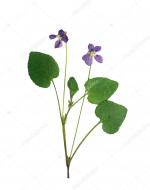Created by Kennedy Johnston on Mon, 04/19/2021 - 16:49
Description:
Gertrude’s commentary:
Here is a violet I picked in remembrance of Phyllis. It has been almost a week and it has yet to dry out. I wonder how long it shall last. She had a great fascination with flowers and violets was her favorite — that was until she developed that relationship of hers with Sidney Darrell. She would always ask me to help pin it to her bodices. She also would always question why I would not join her in wearing them, for I always proceeded to tell her flowers on the bodice were not my cup of tea. Oh, how much I miss my companion, my sister, my dear Phyllis. I despise calling out favorites, but she was mine. We always had a special bond since we were younger but after Mama and Papa died, our bond grew to something I should have appreciated more when she was still with us. I just can not help to think about ways I could have prolonged her childhood. Consumption is a tough battle to fight. Although, I will say that I am happy something like scarlet fever did not take her away. I only say this because consumption allowed her to look even more beautiful on the day of her burial. I should have seen it coming, as prior to her passing her skin greatly resembled the white snow, and her cheeks were as flustered as the color of petunias. I should have taken her to get looked at. There are many things I wish I could have done differently, but I must not show the girls my remorse. I must remain celebratory about her passing, especially to keep the sisters in a jovial mood. All in all, I am glad the suffering was put to an end. She is finally at peace.
Editorial commentary: Tuberculosis is a type of bacterial disease that takes place in the lungs. During the 18th and 19th centuries, tuberculosis managed to become a leading disease, eventually developing into an epidemic. It was considered to be the leading cause of death by a microbial pathogen, resulting in the loss of about one billion lives. Common symptoms included a persistent cough, fever, weight loss, and fatigue (The Tuberculosis Epidemic during Victorian Era). We see Gertrude also refer to the disease as consumption. This was used to describe the most fatal and final stage. This alternative name was widely used by Victorians, like Gertrude herself. Although the disease was detrimental in terms of the increase in mortality rates, it played a large role in how Victorian society viewed female corpses. Women often expressed how they had never seen death so beautifully (Meier). This explains why Gertrude highlights some of Phyllis’s features closer to the end of her life, such as pale skin and rosy cheeks, as consumption resulted in the accentuation of her features. Compared to other epidemics, the effects of consumption fit greatly into Victorian beauty standards. It also played a large contribution to Victorian fashion. The implementation of corsets was related back to the disease as they emphasized and encouraged thin collar bones and a stooping posture, qualities which were also other indications of the disease being present (Newland). Together, this explains why tuberculosis was widely accepted by Victorian society, for it corroborated with the era’s fashion and beauty standards.
Citations:
Meier, Allison. “How Tuberculosis Symptoms Became Ideals of Beauty in the 19th Century.” Hyperallergic, 29 Dec. 2017, hyperallergic.com/415421/consumptive-chic-a-history-of-beaty-fashion-disease/.
Newland, Christina. “The Prettiest Way to Die.” Literary Hub, 9 Apr. 2019, lithub.com/the-prettiest-way-to-die/.
“The Tuberculosis Epidemic during Victorian Era - TB Treatment & History.” FamilyHistory.co.uk, 5 Mar. 2021, www.familyhistory.co.uk/the-tuberculosis-epidemic/.


